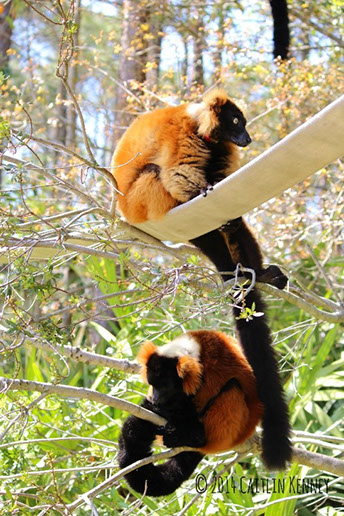Red Ruffed Lemur
Varecia rubra
Conservation status
Critically Endangered (IUCN Red List, 2020)
What they look like
Red ruffed lemurs take their name from their plush chestnut- or orange-red coat, all the more striking because of their black face, tail, chest, and inner arms and legs. White fur marks the base of the head and may appear on hands and feet. They weigh 3.3-3.6 kilograms (about 8 pounds).
Where they live
In the wild, red ruffed lemurs prefer tall trees, climbing to the canopy of tropical lowland rain forests on Madagascar’s Masoala Peninsula. Their thick coats insulate them when the damp turns chilly.
What they eat
Red ruffed lemurs love fruit, which makes up 75-95% of their diet. They are the most frugivorous (fruit eating) of all lemurs. They also suck the nectar out of flowers. Because pollen sticks to their long, furry snouts, they carry it from plant to plant, serving as important pollinators. In the dry season, they may eat leaves and seeds.
How they behave
Active during the day (diurnal), red ruffed lemurs roam the treetops on all fours (quadrupedally), leaping when necessary. When feeding, they may hang by their hind feet. They live in communities ranging from 2 to 30 individuals, a mix of males and females, which are dominant. Groups tend to expand in the wet season and contract in the dry season, when small parties break off to search for food. The size of their home range depends on the size of the group, with larger groups occupying about 60 hectares (about 148 acres). They use scent marking to define and defend their territory.
Red ruffed lemurs are loud, with a variety of calls that can be heard for miles. Red ruffed lemurs bark to stay in touch, to warn off other lemurs who might try to move into their range, and to alert each other when they see a predator.
How they reproduce
The red ruffed breeding season runs from May through July. Males call greetings to females and woo them with scent marking. Pregnancy lasts about 102 days. Females give birth to litters, usually 2-3 infants but sometimes as many as 6. They are tiny, under 100 grams (3.5 ounces). Unlike other diurnal prosimians, red ruffed lemurs do not carry their babies around on their backs. Instead, they stash them in a nest 10-20 meters off the ground. Males and females care for the young. Within a couple of weeks, a mother moves the babies away from the nest, parking them in trees while she looks for food. Many babies fall, resulting in high infant mortality, but those that survive grow quickly.
What threats they face
Natural predators include hawks, boa constrictors, and fossae (the plural for fossa—a large, carnivorous mammal, related to the mongoose with qualities of a cat). Cyclones (hurricanes) also strike the Masoala Peninsula. But human activity—hunting and cutting down ebony and rosewood trees—is far more devastating to red ruffed lemurs. The tall forests they inhabit tempt illegal loggers.
Red ruffed lemurs at LCF’s Florida reserve
LCF’s red ruffed lemurs, the largest bodied lemurs of our colony, participate in the Association of Zoos & Aquarium’s cooperative breeding program to help safeguard the species against extinction, improve the managed population’s genetic diversity, and teach budding conservationists about these engaging animals.
Because Florida is above the equator rather than below, which changes the seasons, the red ruffed lemurs here breed between November and January, and offspring are born around May and June. The young grow extremely rapidly, as the staff at the reserve observed with LCF’s first litter of red ruffed lemurs born in 2007.
At the reserve, the red ruffed lemurs are fed a mixture of fruits, vegetables, and specially formulated primate food (monkey biscuits). For enrichment, they may get flowers, leaves, dried fruit, or baby food. In the forest, they prefer the large horizontal branches of the live oaks but move quickly, agilely, and frequently through the crowns of our tallest slash pines.
The staff at the reserve often use the patches of white found on the hands and feet to distinguish one individual from another.
